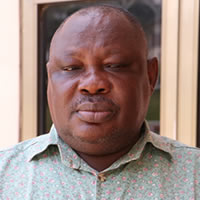Potable water supply in the urban/peri-urban areas has been a major challenge to the Assembly, especially when the Assembly has no direct control over urban water supply. In spite of this, each settlement has a form of water supply system, the predominant being boreholes and wells. In most remote villages irrespective of size, boreholes and wells have been provided.
The achievement is due to the collaborative effort between Assembly, Ghana Water Company’s and other development partners such as DANIDA District Based Water and Sanitation Program and Oboaba Rural Action Program (ORAP). Most households use a combination of water supply systems because of water shortage. Figure 5 shows distribution of water facilities . Some of the problems that need to be solved and the challenges to mange to ensure the achievement of the set target include:
- Enlisting the full participation of women at all levels of the programme
- Improving the weak financial capacity of the Water and Sanitation Development Boards (WSDB)
- Providing adequately trained and experienced technical staff on its WSDB
- Over dependence on Donor support for water facilities
- Increasing and sustaining the participation of communities especially with capital cost contribution
- Sustainable supply chain for goods and services for the operation and maintenance of water facilities
On the issue of sanitation, it appears that a number of people have access to some type of sanitation facilities either public or private. Others also resort to indiscriminate defecation in gutters, school compound and public refuse dumps. Total sanitation coverage is estimated at 40% for domestic and 20% for institutions.
The types of facilities in use include WC toilets, KVIPs, Household VIPs and public KVIPs. Pit latrine even though not approved by the Assembly is being used by some households even in the urban communities. The Assembly is currently participating in the District Based Water and Sanitation Component of the Community Water and Sanitation Programme to improve the provision of such facilities in the various institutions in the Municipality.
Under the Community Based Rural Development Project some sanitation facilities are also being constructed in selected schools. In all these projects the Assembly contributes to the capital cost.
The integration of the three complementary elements of safe water, improved sanitation and hygiene promotion is to ensure that the health benefits are maximized for productivity to increase and the ultimate goal of reduction of poverty.
Some of the challenges in this sector include:
- Ensuring sustained sanitation and good hygiene practices in the various communities and schools
- Provision of adequate sanitation facilities in the various schools and other institutions Ensure the use of approved sanitation facilities in the various homes . An average of 10 people use one latrine o Not more than an average of 50 people per squat hole
Liquid Waste
Apart from settlements in the municipality lacking improved toilet facilities, most of the existing public toilets are not well constructed. The main types of toilet facilities are K.V.I.P, pit, Aqua Privy, septic and pan latrines as the water table is high there is the risk of contamination. The stench, associated with pit latrine pollutes the air and this presupposes that it should be distanced form the communities, taking due cognizance of the prevailing wind direction.
Some communities do not have any toilet facilities and this makes indiscriminate defecation the normal practice. This poses health hazards to the inhabitants of the settlements since run-offs wash the human excreta into streams, thus contaminating them. The result of the baseline survey carried out by the DPCU indicates that 27% of houses surveyed within the district have toilets facilities.
This figure is low and efforts must be made to encourage the provision of at least one VIP toilet in every house, especially in the urban settlements. In respect of other facilities, 87.2% of houses have bathrooms. Plans should be made by the Assembly to construct more septic tan/KVIP toilets in the municipality. Also the Assembly should assist house-owners in the towns by granting them loans to construct VIP toilets in their private houses, thus reducing pressure on public toilets.
Liquid Household Waste and Storm-Water Disposal
Wastewater from houses is normally dislodged into open earths, which are not maintained in most of the urban settlements. The result is the choked drains and small ponds/streams. These become breeding ground for mosquitoes, which cause malaria ranked No.1 on the list of Top Ten diseases. In addition, the odour and stench emanating from such areas pollute the air and is very much abominable.
In smaller communities household waste water and run-offs are not considered in any way as they drain on to the narrow lanes to create gullies, and unto lower areas in the bush to create ponds.
The situation requires an urgent attention since this could lead to an epidemic. Foundation of most of the houses is exposed, causing damage to these buildings. There is therefore the need to plan settlements with drains through which household water can be properly channeled.
Tree and grass planting should be encouraged so as to protect the soil from sheet erosion and to serve as wind breaks for the buildings, provide shade and have an aesthetic effect on the houses and settlement in general. As a result of abuse of the environmental resources, some settlements are experiencing environmental degradation.
A significant part of the land, forest, wild life and water resources are seriously threatened by this degradation. To contain the situation and restore ecological balance in the municipality, there is the need to initiate a forestation, tree planting and community wood lot programmes in the settlements. There is also the need to educate the people in sustainable resource-use and land use practices. A legislation to control timber firms, chain-saw operators and charcoal burning in the mis need to be effectively implemented to reduce pressure on the remaining forests. The Task Force must be rewarded for any arrest made.
Solid Waste/Garbage
The rate of waste generation and management is a matter of concern to the Assembly. With the increasing influx of people and the rapid urbanization, huge amounts of human and industrial waste are generated at an alarming rate. It is estimated that about 950 tonnes of solid waste is generated monthly out of which 480 tonnes are collected which represents about 51%.
This leaves a substantial amount of backlog that creates various kinds of inconveniences including health hazard to people in the municipality. Most communities have designated sanitary sites -open dumping at the outskirts of the settlement. This is however not burnt and no recourse to final disposal points. This has been the cause of outbreak of diseases like diarrhea .
House-to house garbage collection is non- existent . Refuse Mountains, which used to be in the capital, Nkawkaw, have been cleared and containers placed in vantage points for refuse collection. Lack of equipment at times delays the emptying of these containers, thus containers over-flow and litter is scattered around.
The situation is compounded by the inadequate machinery and equipment by the Assembly. Also the absence of proper engineered final disposal site is a major constraint. Even though the assembly has been able to acquire a final disposal site, it is yet to develop the site. It was observed that sanitation was improving with the introduction and subsequent operation of the ZOOMLION Sanitation Program in the municipality.
It is however recommended that proper management of refuse be put in place to ensure good sanitation, especially in Nkawkaw township, Further.it is and it is strongly recommended that a consultant be engaged to further study the garbage management . Some of the challenges in this sector include:
- Inadequate numbers of refuse containers
- Irregular and untimely refuse collection
- Lack of engineered final disposal site
- Inadequate machinery and equipment
Date Created : 11/26/2017 2:06:58 PM





